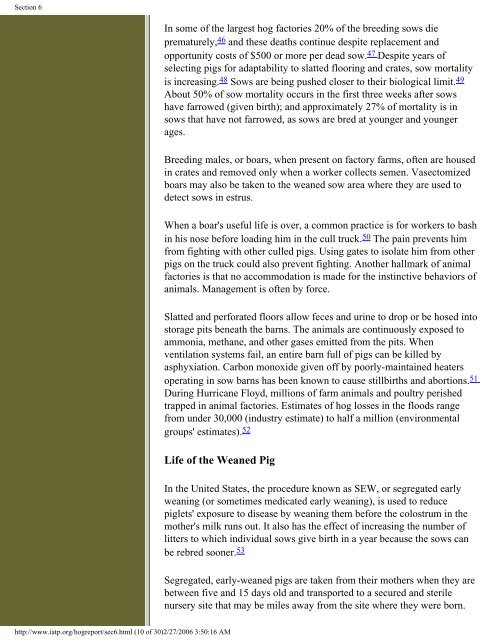IATP Hog Report - Institute for Agriculture and Trade Policy
IATP Hog Report - Institute for Agriculture and Trade Policy
IATP Hog Report - Institute for Agriculture and Trade Policy
Create successful ePaper yourself
Turn your PDF publications into a flip-book with our unique Google optimized e-Paper software.
Section 6<br />
In some of the largest hog factories 20% of the breeding sows die<br />
prematurely, 46 <strong>and</strong> these deaths continue despite replacement <strong>and</strong><br />
opportunity costs of $500 or more per dead sow. 47 Despite years of<br />
selecting pigs <strong>for</strong> adaptability to slatted flooring <strong>and</strong> crates, sow mortality<br />
is increasing. 48 Sows are being pushed closer to their biological limit. 49<br />
About 50% of sow mortality occurs in the first three weeks after sows<br />
have farrowed (given birth); <strong>and</strong> approximately 27% of mortality is in<br />
sows that have not farrowed, as sows are bred at younger <strong>and</strong> younger<br />
ages.<br />
Breeding males, or boars, when present on factory farms, often are housed<br />
in crates <strong>and</strong> removed only when a worker collects semen. Vasectomized<br />
boars may also be taken to the weaned sow area where they are used to<br />
detect sows in estrus.<br />
When a boar's useful life is over, a common practice is <strong>for</strong> workers to bash<br />
in his nose be<strong>for</strong>e loading him in the cull truck. 50 The pain prevents him<br />
from fighting with other culled pigs. Using gates to isolate him from other<br />
pigs on the truck could also prevent fighting. Another hallmark of animal<br />
factories is that no accommodation is made <strong>for</strong> the instinctive behaviors of<br />
animals. Management is often by <strong>for</strong>ce.<br />
Slatted <strong>and</strong> per<strong>for</strong>ated floors allow feces <strong>and</strong> urine to drop or be hosed into<br />
storage pits beneath the barns. The animals are continuously exposed to<br />
ammonia, methane, <strong>and</strong> other gases emitted from the pits. When<br />
ventilation systems fail, an entire barn full of pigs can be killed by<br />
asphyxiation. Carbon monoxide given off by poorly-maintained heaters<br />
operating in sow barns has been known to cause stillbirths <strong>and</strong> abortions. 51<br />
During Hurricane Floyd, millions of farm animals <strong>and</strong> poultry perished<br />
trapped in animal factories. Estimates of hog losses in the floods range<br />
from under 30,000 (industry estimate) to half a million (environmental<br />
groups' estimates). 52<br />
Life of the Weaned Pig<br />
In the United States, the procedure known as SEW, or segregated early<br />
weaning (or sometimes medicated early weaning), is used to reduce<br />
piglets' exposure to disease by weaning them be<strong>for</strong>e the colostrum in the<br />
mother's milk runs out. It also has the effect of increasing the number of<br />
litters to which individual sows give birth in a year because the sows can<br />
be rebred sooner. 53<br />
Segregated, early-weaned pigs are taken from their mothers when they are<br />
between five <strong>and</strong> 15 days old <strong>and</strong> transported to a secured <strong>and</strong> sterile<br />
nursery site that may be miles away from the site where they were born.<br />
http://www.iatp.org/hogreport/sec6.html (10 of 30)2/27/2006 3:50:16 AM

















